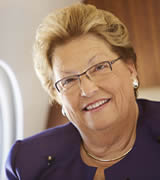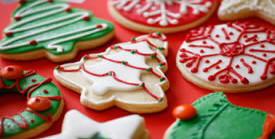| |
 |

Paula Kraft,
founder and President of Atlanta, GA-based Tastefully
Yours Catering. |
|
|
|
The
Tradition of Holiday Cookies |
|
|
|
|
 |
an you smell the cinnamon, ginger, cardamom and anise aroma of cookies baking in the
oven this time of year? Can you taste the delicate butter cookie as it melts in your mouth
and congers up memories of your childhood? |
So, there you have it . . . the rich smell of butter shortbreads baking causes me to wonder where the Holiday cookie began? My mouth waters, and my heart warms, as I imagine Christmas cookies.
|
Christmas Cookies are a way of sharing my family’s love of tradition
with the rest of you. I love the time of year we refer to as ‘Cookie
Season’ in our kitchen.
My sister and our
daughters - alongside the pastry chef - begin the dough mixing and
planning the family cookies that we’ll be baking for the aircraft
this year. |
 |
As many of you know, I love
trivia. Bits of information on all kinds of topics that you don’t necessarily
need to know, but I find it fun! I have always questioned the ‘why’, ‘when’ or
‘where’ of things. I always wanted to know why does
this happen, or what can be done to improve
that product . . . and who came up with
this concept?
So where did the Christmas cookie come from?
It turns out that baking cookies
came from the medieval middle ages, when celebrations and holidays inspired the
use of highly prized and uncommon ingredients. Sugar was very expensive and
rare, and at one point in its history could cost over a $100.00 per pound, so
was used only by the wealthy on very special occasions. Flour was a staple
ingredient and necessary for sustenance, so it couldn’t be wasted on baking
sweets - unless it was for a celebration. Instead flour was used for baking
breads and biscuits necessary to fill one’s belly . . .
Gingerbread, known as Lebkuchen, is thought to be the first mini cake/cookie associated with the holidays and has been a symbol since the 1500s. German cookie - or mini cake - baking was led by the Lebkuchen and Spritz recipes because they used less sugar; but more spices, raisins and dried fruit for flavor and
sweetness. Originating during the Crusades, it was made with breadcrumbs boiled with honey and heavily seasoned with spices. It was dried on wooden boards, and centuries later was pressed into shapes such as animals or people. Over the years it was evolved to decorate trees as edible ornaments.
Did you know that the American animal crackers were originally sold in a decorated box with a cord handle to hang on the Christmas tree? Sorry, I digress with another bit of trivia . . .
Anyway, the word ‘cookie’ actually comes to us from the Dutch. The Dutch word Koeptje (koekje), meaning ‘small cake’, was first used by people in the Persian Empire of the 7th century AD. These first cookies were highly prized and were quickly introduced into European baked goods for all celebrations.
Depending on the part of the world you are from, or traveling to during this holiday season, you may be greeted with the Swedish Papparkakor , (a spicy ginger and black pepper cookie), or the Norwegian lemon and cardamom wafer.
As people migrated around the globe, it’s no wonder they took with them their culture’s recipe of cookies from home and the family traditions they loved. The Holiday cookie is now shared as a symbol of kindness.
Each country has their own specialty for Christmas such as the Scottish shortbread and Italian Pizzelles, a crisp wafer cookie. For Britain and Ireland, Scottish shortbread (traditionally eaten at New Year) and ginger biscuits are the specialty of the region. Greece brings us the Melomakarona , a cookie made of cinnamon and cloves and soaked in heavy honey and sprinkled in sesame seeds, walnuts and cinnamon.
Eastern Europe offers the Kolaczki . . . a flakey cookie made with a buttery cream cheese dough filled with fruit or sweet cheese filling. The Latin Caribbean and Mexico offer us the Besitos de Coco (coconut kisses). Mexico is also known for the Mexican Wedding cookie, a powdered sugar dusted cookie ball. A small crumble cake which is light and delicate with an anise flavor called Mantecado is of Spanish decent. The French offer caramelized cinnamon palmiers and ladyfingers also known as Boudoir biscuits, sponge fingers or biscuits a la
cuiller. They have changed little since the 11th century.
In addition to the Pizzelle, Italy also originated the macaroon in 1792; they have a soft interior and crisp crusty outside and come in assorted flavors of chocolate, coffee and numerous other spices. South American countries bake a crisp sandwiched cookie filled with caramel called Alfajores. Australia and New Zealand have a chocolate oat cookie decorated with colored sprinkles. From Scandavian countries, our famous Danish Pepper Nuts from my grandmother’s recipe file is a favorite offering during the holidays at Tastefully Yours. We mix the spices a month in advance and allow them to marry together before baking so the flavor is bold and memorable.
Another side note of holiday candy - not a far stretch from the sweet treats and cookies – are Candy canes. They were originated in the 1800’s. A bit if trivia for you here; there are several thoughts about their origin. One is that they were made by a priest to give the children to keep them quiet during the services, and that the curve in the cane could have been representative of the staff of Joseph, or even the letter “J” standing for Jesus, or created simply as a decoration to hang on a Christmas tree. Whatever the original reason, they too have become a holiday
tradition. Another bit of holiday trivia . . . Cookies for Santa is believed to have been started during the great depression and was a way parents taught their children the value of sharing.
I encourage you to sample the
Holiday cookies of the various countries of the world as you travel the globe. Taste and share in the world’s family traditions of the season. We at
Tastefully Yours Catering have used, and continue to use, the recipes that came to America by my ancestors from Germany, Sweden, and England. Their recipes have been held close within the family to be baked and then gifted and shared with our many family and friends.
As you pass around a plate of Holiday cookies on board the aircraft or sample in the lobby of your favorite FBO, from your travels around the world, I hope you can savor their beauty and taste what fills you with fond loving memories of the season.
My wish to each of you is health, happiness, joy and peace in the coming year.
| |
|
 |
|
|
About Paula Kraft . . .
Paula Kraft is the
founding partner of the DaVinci Inflight Training Institute located in
Fort Lauderdale, Florida and the founder/president of Tastefully Yours
Catering, an aviation specific caterer, located in Atlanta, Georgia for
over 35 years.
Paula is active with
many aviation and catering-related groups including the International
Caterers Association, the International Inflight Food Service
Association and is a board member of Women in Corporate Aviation. She is
the past chair of the NBAA Flight Attendant Committee Caterer’s Working
Group for 15 years perfecting unique catering training sessions for NBAA
conferences and events. Currently, she serves on the NBAA Flight
Attendant Advisory Committee and is a member of the Training and Safety
Subcommittee. Paula was a founding member of the Steering committee for
the creation of a European Flight Attendant Committee and conference and
serves as a subject matter expert to the board of International Standard
for Business Aircraft Handlers (IS-BAH).
|
After founding
Tastefully Yours Catering, she has been offering culinary
and food safety related training to the general aviation
community. With a strong dedication to improving catering
safety, risk mitigation and safe food handling, she
developed and introduced the concept of “catering safety
management systems”. As a certified food safety instructor,
Paula offers catering SMS and culinary classes for all
aviation professionals.
Paula’s
first-hand experience, business acumen, research, and
relationships make her an industry expert - one which allows
her to share information that will help raise the
professional training level for flight attendants today that
will reduce the risk of food-related concerns tomorrow.
|
 |
From Paula . . .
I have coordinated
training programs and clinics for NBAA and EBAA conference attendees for
over 10 years, created mentoring programs for caterers and flight
attendants to broaden their aviation culinary skills, and to assist them
in adapting to the unique challenges and constraints found in catering
for general aviation. I recognize the need for training and have worked
closely with flight departments, flight crews, schedulers and customer
service reps at the FBOs to ensure that catering specific training
provides information and skills necessary to reduce risk while assisting
them in their job duties that include safe food handling, catering
security, accurate transmission of food orders, and safe food
production, packaging and delivery.
I fell into aviation
catering quite by accident. I was the in-house caterer and bakery
supplier for Macy’s department stores in Atlanta when catering was
ordered for a Macy’s customer which was soon to change my life. After
the client enjoyed the catering provided, I was summoned to the client’s
corporate office to provide several of the items delivered through
Macy’s to the executive dining room. Within a week, I was providing food
for the flight department and my first order was for the President of a
foreign country (as I was too be told soon after).
So, here I am, some 35
years later, still loving every minute of every day in aviation
catering.
|
| |
|
BlueSky Business Aviation News | 21st December
2017 | Issue #444 |
|
|
 |
|
|
|

